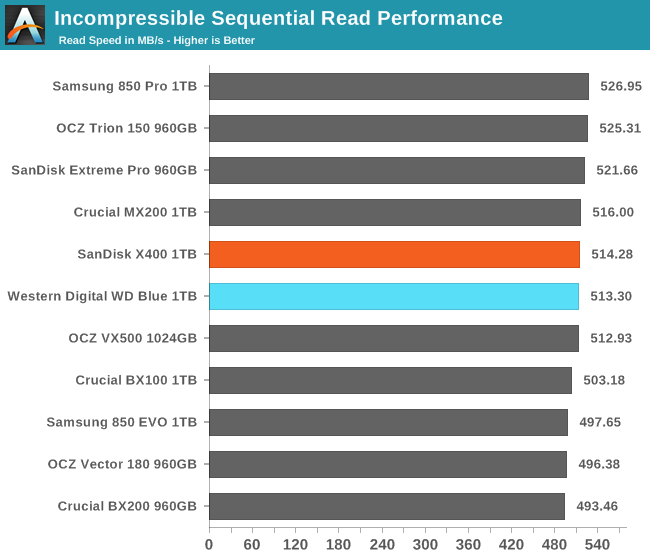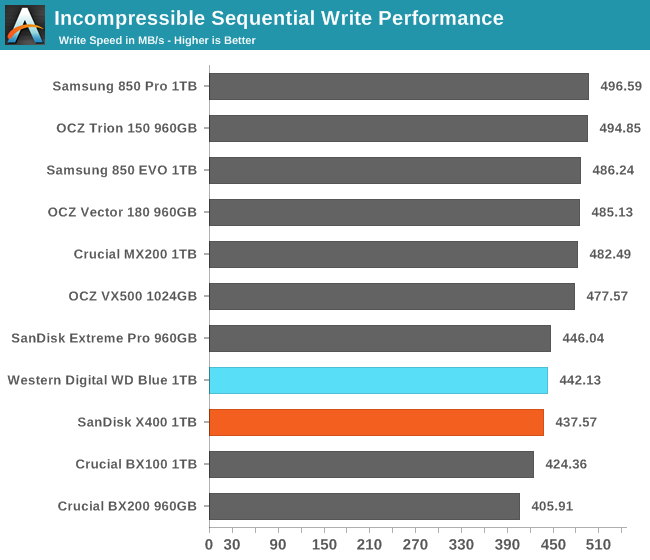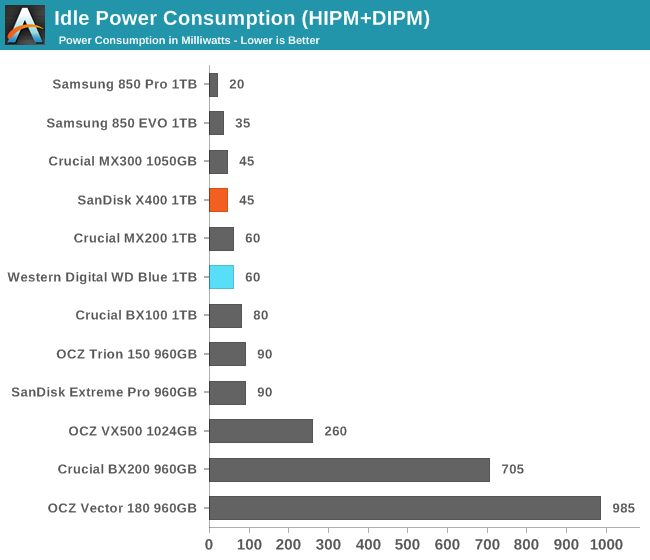The Western Digital Blue (1TB) SSD Review: WD Returns to SSDs
by Billy Tallis on October 11, 2016 8:00 AM EST- Posted in
- SSDs
- Storage
- Western Digital
- SanDisk
ATTO
ATTO's Disk Benchmark is a quick and easy freeware tool to measure drive performance across various transfer sizes.
 |
|||||||||
The WD Blue shows slightly better write speeds on the ATTO test than the SanDisk X400, but both fade a bit in read speed toward the end of the test.
AS-SSD
AS-SSD is another quick and free benchmark tool. It uses incompressible data for all of its tests, making it an easy way to keep an eye on which drives are relying on transparent data compression. The short duration of the test makes it a decent indicator of peak drive performance.


The AS-SSD test seldom shows large differences in performance, and the WD Blue performs almost identically to the X400. The write speed is still a bit on the low side.
Idle Power Consumption
Since the ATSB tests based on real-world usage cut idle times short to 25ms, their power consumption scores paint an inaccurate picture of the relative suitability of drives for mobile use. During real-world client use, a solid state drive will spend far more time idle than actively processing commands. Our testbed doesn't support the deepest DevSlp power saving mode that SATA drives can implement, but we can measure the power usage in the intermediate slumber state where both the host and device ends of the SATA link enter a low-power state and the drive is free to engage its internal power savings measures.
We also report the drive's idle power consumption while the SATA link is active and not in any power saving state. Drives are required to be able to wake from the slumber state in under 10 milliseconds, but that still leaves plenty of room for them to add latency to a burst of I/O. Because of this, many desktops default to either not using SATA Aggressive Link Power Management (ALPM) at all or to only enable it partially without making use of the device-initiated power management (DIPM) capability. Additionally, SATA Hot-Swap is incompatible with the use of DIPM, so our SSD testbed usually has DIPM turned off during performance testing.


The WD Blue uses a few milliwatts more at idle than the X400. In the slumber state this is not a problem and the WD Blue's power draw is about average. The active idle power draw is a bit on the high side given that the MX300 draws about two thirds what the WD Blue draws when both drives use the same controller and DRAM.










75 Comments
View All Comments
Magichands8 - Wednesday, October 12, 2016 - link
That's funny you should say that since I've been noticing it for years. Every single time I move around large files to reorganize or back them up, in fact. But I'm sure that I'm the only non-video editing person on the planet who doesn't use his computer exclusively for reading and writing tiny text files and browsing the internet. I'm also sure that I'm the only who would have a problem paying a premium for very low capacity devices just so I could experience their limitations.Michael Bay - Thursday, October 13, 2016 - link
Oy vey, nobody in the market cares for my special snowflake wants, it`s anudda shoah!mapesdhs - Friday, October 14, 2016 - link
You need more explosions in your posts. ;Dbeginner99 - Wednesday, October 12, 2016 - link
It's cheap but not really excitingly cheap. Doesn't really beat the aged MX200 which also comes with MLC NAND which I deem superior to this TLC low-end crap. Only advantage this has over MX200 is price. Good for a cheapo game-drive maybe but would avoid as OS drive.Arnulf - Wednesday, October 12, 2016 - link
Ewww, 15nm planar TLC along with WD branding.JimmiG - Wednesday, October 12, 2016 - link
I remember the time when the 850 Evo was considered a "budget" SSD. Now it's almost a high-end SSD.haukionkannel - Wednesday, October 12, 2016 - link
And the price of evo is still going up. Hopefully there will be stop to it eventually.Impulses - Wednesday, October 12, 2016 - link
It's not really going up, just plateau'ing hard, sales might be happening slightly less frequently lately, I dunno... I do remember seeing the 1TB under $300 a number of times but it's mostly been just over $300 for well over a year.I paid $320-ish for two back in July-August 2015 when they were first starting to get close to $300. It's still faster than the field and brand alone is probably sustaining their ability to charge a premium.
mapesdhs - Friday, October 14, 2016 - link
Maybe it depends on where you live, but the 850 EVO went up a lot where I am (UK). Back in Jan this year the 250GB was 53 UKP, now the same model is 85 UKP. Samsung is exploiting demand for what used to be a well priced, reliable product to give the model a premium image that's pushing its cost far above where it really should be. This has happened before, eg. when the 830 series shot up in early 2013 after strong demand, which helped ensure all other brands didn't lower their prices.TheinsanegamerN - Friday, October 14, 2016 - link
what HASNT shot up in price in the UK post-Brexit vote?